Cave Paintings in India
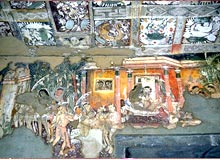 Cave paintings of India date back to the prehistoric times. The finestexamples of these paintings comprise of the murals of Ajanta, Ellora, Bagh, Sittanavasal, etc, which reflect an emphasis on naturalism. Ancient cave paintings of India serve as a window to our ancestors, who used to inhabit these caves. In the following lines, we have provided more information on the ancient Indian rock paintings:
Cave paintings of India date back to the prehistoric times. The finestexamples of these paintings comprise of the murals of Ajanta, Ellora, Bagh, Sittanavasal, etc, which reflect an emphasis on naturalism. Ancient cave paintings of India serve as a window to our ancestors, who used to inhabit these caves. In the following lines, we have provided more information on the ancient Indian rock paintings:Ajanta Paintings
Ajanta caves are located at a distance of approximately 100 km from the city of Aurangabad. Most of the paintings seen in the Ajanta Caves, date back to the period of the Mahayana sect of Buddhism. The themes of most of these paintings revolve around the life and teachings of Lord Buddha. This includes the Jataka stories related to the various lives and incarnations of Buddha. Calligraphic lines characterize these paintings, which can be classified into portraits, narrative illustrations and ornamental decoration.
Ellora Paintings
Ellora caves are nestled amidst the Chamadari Hills, lying approximately 18 miles to the northeast of Aurangabad city. Paintings can be found in five caves. However, all of them are today preserved only in the Kailasa temple. The rock paintings of Ellora were painted in two different series. The first series, which were done when the caves were carved, revolve around Lord Vishnu and Goddess Lakshmi. The second series, painted centuries later, illustrate procession of Shaiva holy men, Apsaras, etc.
Bagh Paintings
Bagh caves, situated on the banks of the Bagh River, have been excavated on the rock face of a lofty hill. The wall paintings of these caves date back to period between 5th and 7th century. These paintings represent the mast exquisite traditions of Indian art form.
Sittanavasal Paintings
Sittanavasal is the site of an ancient Jain Monastery, located at a distance of around 58 km from Trichy. The monastery is known for housing some of the most exquisite frescoes in a rock cave. Most of these cave paintings are based on the Pandyan period of the 9th century. The themes of these paintings include animals, fish, ducks, people collecting lotuses from a pond, two dancing figures, etc. Apart from that, one can also find inscriptions dating back to the 9th and 10th century. The ceiling of the Ardhamandapam is adorned with murals from the 7th century.
Madhubani Painting
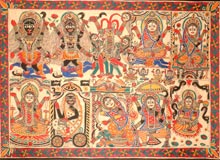
Madhubani painting originated in a small village, known as Maithili, of theBihar state of India. Initially, the womenfolk of the village drew the paintings on the walls of their home, as an illustration of their thoughts, hopes and dreams. With time, the paintings started becoming a part of festivities andspecial events, like marriage. Slowly and gradually, the Madhubani painting of India crossed the traditional boundaries and started reaching connoisseurs of art, both at the national as well as the international level.
The traditional base of freshly plastered mud wall of huts has now been replaced by cloth, handmade paper and canvas. Since the paintings have been confined to a limited geographical range, the themes as well as the style are, more or less, the same. Indian Maithili paintings make use of three-dimensional images and the colors that are used are derived mainly from plants. The themes on which these paintings are based include nature and mythological events. The first reference to the Maithili painting of Bihar dates back to the time of Ramayana, when King Janaka ordered the paintings to be created for his daughter, Sita's, wedding.
Themes of Maithili Paintings
Themes of the Maithili painting of Bihar revolve around Hindu deities like Krishna, Rama, Lakshmi, Shiva, Durga and Saraswati. The natural themes that are used include the Sun, the Moon and the religious plants like tulsi. One can also find paintings based on scenes from the royal courts and social events, like weddings. If any empty space is left after painting the main theme, it is filled up with the motifs of flowers, animals and birds or geometric designs.
Making Madhubani Paintings
The brush used for Madhubani paintings of Bihar was made of cotton, wrapped around a bamboo stick. The artists prepare the colors that are used for the paintings. Black color is made by adding soot to cow dung; yellow from combining turmeric (or pollen or lime) with the milk of banyan leaves; blue from indigo; red from the kusam flower juice or red sandalwood; green from the leaves of the wood apple tree; white from rice powder and orange from palasha flowers. There is no shading in the application of colors. A double line is drawn for outlines and the gap is filled with either cross or straight tiny lines. The linear Maithili paintings do not even require application of colors; only the outlines are drawn.
Miniature Painting
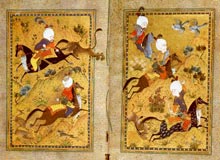 Miniatures paintings are beautiful handmade paintings, which are quite colorful but small in size. The highlight of these paintings is the intricate and delicate brushwork, which lends them a unique identity. The colors arehandmade, from minerals, vegetables, precious stones, indigo, conch shells, pure gold and silver. The most common theme of the Miniature painting of India comprises of the Ragas i.e., the musical codes of Indian classical music. There were a number of miniature schools in the country, including those of Mughals, Rajputs and the Deccan.
Miniatures paintings are beautiful handmade paintings, which are quite colorful but small in size. The highlight of these paintings is the intricate and delicate brushwork, which lends them a unique identity. The colors arehandmade, from minerals, vegetables, precious stones, indigo, conch shells, pure gold and silver. The most common theme of the Miniature painting of India comprises of the Ragas i.e., the musical codes of Indian classical music. There were a number of miniature schools in the country, including those of Mughals, Rajputs and the Deccan. History of Miniature Painting in India
The evolution of Indian Miniatures paintings started in the Western Himalayas, around the 17th century. These paintings were highly influenced by the mural paintings that originated during the later half of the 18th century. During the time of the Mughals, Muslim kings of the Deccan and Malwa as well as the Hindu Rajas of Rajasthan, this art flourished to quite an extent. Infact, the Mughals were responsible for introducing Persian tradition in the Miniature paintings of India. The credit for western influence can be ascribed to the Muslim kings.
Schools of Miniature Painting
The different schools of the Miniature paintings of India include:
- Pala School
- Orissa School
- Jain School
- Mughal School
- Rajasthani School
- Nepali School
These schools were the products of hothouse cultivation that was practiced over generations. The earliest instances of the Indian Miniature painting are those related to the Pala School and date back to the 11th century. This school emphasized on the symbolic use of color in the paintings, which was taken from tantric ritual. The other characteristics of the Pala School include the use of a skillful and graceful line, modeling forms by delicate and expressive variation of pressure, use of natural color for painting human skin, etc
The Jain School of Miniature paintings laid great emphasis on style. The unique features of this school include strong pure colors, stylish figures of ladies, heavy gold outlines, diminution of dress to angular segments, enlarged eyes and square-shaped hands. One can see the influence of Jain miniature paintings on Rajasthani and Mughal paintings also.
Mughal Painting
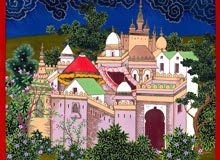 Mughal painting reflects an exclusive combination of Indian, Persian and Islamic styles. As the name suggests, these paintings evolved as well as developed during the rule of Mughal Emperors in India, between 16th to 19th century. The Mughal paintings of India revolved around themes, like battles, court scenes, receptions, legendary stories, hunting scenes, wildlife, portraits, etc. The Victoria and Albert Museums of London house a large and impressive collection of Mughal paintings.
Mughal painting reflects an exclusive combination of Indian, Persian and Islamic styles. As the name suggests, these paintings evolved as well as developed during the rule of Mughal Emperors in India, between 16th to 19th century. The Mughal paintings of India revolved around themes, like battles, court scenes, receptions, legendary stories, hunting scenes, wildlife, portraits, etc. The Victoria and Albert Museums of London house a large and impressive collection of Mughal paintings.History of Mughal Painting
Indian Mughal paintings originated during the rule of Mughal Emperor, Humayun (1530-1540). When he came back to India from the exile, he also brought along two excellent Persian artists, Mir-Sayyid Ali and Abd-us-samad. With time, their art got influenced by the local styles and gradually; it gave rise to the Mughal painting of India. The earliest example of the Mughal style is the Tutinama ('Tales of a Parrot') Painting, now in the Cleveland Museum of Art. Then, there is the 'Princess of the House of Timur', a painting redone numerous times.
Under Akbar
Under Jahangir
Emperor Jahangir reigned from 1605 to 1627 and extended great support to various art forms, especially paintings. This period saw more and more refinement in brushwork, along with the use of much lighter and subdued colors. The main themes of the Mughal paintings revolved around the events from Jahangir's own life, along with portraits, birds, flowers, animals, etc. One of the most popular examples of Mughal paintings of this time include the pictorial illustrations of the Jehangir-nama, the biography of Emperor Jahangir.
Under Shah Jahan
The grace and refinement of the Jahangir period was seen at the time of Emperor Shah Jahan (1628-1658). However, the sensitivity of the paintings was replaced by coldness and rigidity. The themes of that time revolved around musical parties, lovers on terraces and gardens, ascetics gathered around a fire, etc.
Decline of Mughal Painting
The trend that was seen during the time of Shah Jahan was also found under the rule of Aurangzeb (1658-1707). However, the emperor did not pay too much attention on the growth of the Mughal paintings. Still, the art form continued to survive with the support received from its other patrons. However, gradually, because of diminishing support, a declining trend set in. The time of Muhammad Shah, (1719-1748), did experience a brief revival of the Mughal paintings. Nonetheless, with the arrival of Shah Alam II (1759-1806), the art almost became extinct and another school of painting, known as Rajput paintings, started evolving.
Mysore Paintings
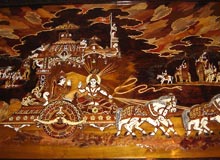
Mysore Painting is a form of classical South Indian painting, which evolved in the Mysore city of Karnataka. During that time, Mysore was under the reign of the Wodeyars and it was under their patronage that this school of painting reached its zenith. Quite similar to the Tanjore Paintings, Mysore Paintings of India make use of thinner gold leaves and require much more hard work. The most popular themes of these paintings include Hindu Gods and Goddesses and scenes from Hindu mythology. The grace, beauty and intricacy of Indian Mysore Paintings leave the onlookers mesmerized.
History of Mysore Paintings
It was under the rule of Raja Krishna Raja Wodeyar that the popularity of the Mysore School of painting reached its highest point. However, after the Raja expired in 1868, the artists started scattering and the school reached the point of total extinction. The year 1875 saw theestablishment of Jagan Mohan Palace and Chitrakala School and along with it, the revival of the Mysore Painting of India. Late Sri Siddalingeswara Swamiji and late Sri Y. Subramanya Raju also contributed to this exquisite art form. Making Mysore Paintings
A number of steps are involved in the process of producing a Mysore painting. The first step requires the artist to make apreliminary sketch of the image on the base, which comprises of a cartridge paper pasted on a wooden base. Thereafter, he makes a paste of zinc oxide and Arabic gum, known as 'gesso paste'. This paste is used to give a slightly raised effect of carving to those parts of the painting that require embellishments and is allowed to dry. Then, gold foil is pasted onto the surface. The rest of the painting is prepared with the help of watercolors. After the painting is fully dried, it is covered with a thin paper and rubbed lightly with a smooth soft stone.
In the traditional Mysore paintings, all the inputs were made by the artists, including brushes, paints, board, gold foil, etc. Instead of the poster colors and watercolors of today, vegetable and mineral colors were used. Even the base was formed of paper, wood, wall and cloth, rather than the sole cartridge paper base used now. The sketches were made with the help of charcoal, which was prepared by burning tamarind twigs in an iron tube. The brushes were made of different materials, like squirrel hair, camel hair, goat hair, etc.
